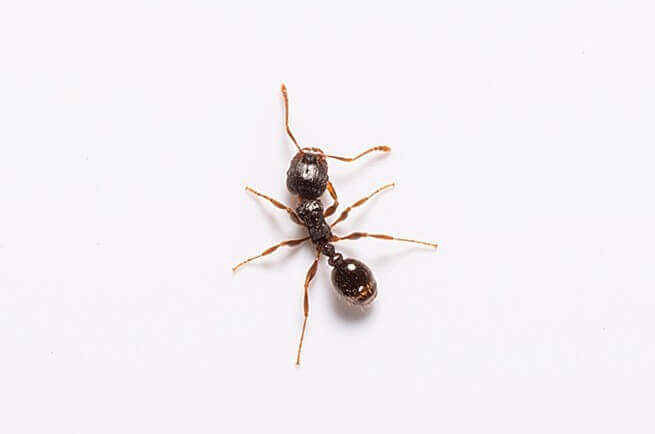What Do Pavement Ants Look Like?
Pavement ants range from dark reddish-brown to black. They have a shiny abdomen and light-colored limbs. Workers are tiny at an eighth of an inch in length, while winged reproductives are about twice that size. Since the insects look so similar to other species, nesting sites are the best way to identify pavement ants.

How Can I Tell if I Have a Pavement Ant Problem?
Outside, the pests dig nests beneath rocks, logs, and sidewalks. Indoors, pavement ant colonies are much harder to find because the insects forage at night and live under floors and inside walls. However, there are a few tell-tale signs of pavement ant infestation:
- Dirt Mounds – The pests leave circular piles of soil on the surface when they dig into the ground. These mounds of dirt often appear next to foundations, between patio bricks, or near cracks in driveways and parking lots.
- Trails – Workers move in long lines across floors and under carpets, traveling back and forth from the nest and their food sources. You may see pavement ant trails on countertops and prep surfaces in kitchens, cafeterias, and office lunchrooms as well.
- Swarms – Winged male and female ants fly away from the colony in groups so they can mate. When the insects live indoors, you may see them swarm near windows as they try to get outside.
How Do Pavement Ants Get Inside Homes and Businesses?
A pavement ant can come inside through tiny openings in foundations or gaps around door and window frames. Once indoors, they seek out moisture and food. Sweets, protein, and grain products attract pavement ants to kitchen cabinets and pantries.
College dining halls, bars, and restaurants appeal to pavement ants as a steady source of meals. Large commercial spaces, such as factories and warehouses, may see extensive infestations. Tiny foundation cracks give the ants access, and they use wiring and pipes to spread throughout the building.
Are Pavement Ants Dangerous?
Overall, unlike carpenter ants and the damage they can do, pavement ants are just a nuisance. The pests do have stingers, but they’re harmless against human skin. The insects also don’t bite or transmit disease. While their digging may cause patios and walkways to shift over time, pavement ants don’t cause any serious damage to buildings.
However, pavement ants do contaminate stored goods and food items, affecting both homes and businesses. Restaurants, cafeterias, and bakeries that store staples like sugar, flour, and other common meal ingredients are at risk. Office break rooms and cubicles can also have pavement ant problems, especially if employees keep snacks or sweetener packets in their desks.
How Can I Prevent Pavement Ant Infestations?
To avoid pavement ant issues, keep kitchen and storage areas clean and free from crumbs. Wipe up any spills right away. Store food in tightly closed containers and remove pet dishes after meals. Rinsing off recyclables and emptying trash cans frequently helps deter pavement ants, too.
Outside, fix any damage to slabs or foundations to stop pavement ants from getting inside. Remember to check for gaps near water heaters or utility connections. Make sure to seal doors and windows and repair any torn screens. For assistance with pavement ants – or any ant – call the professionals at Waltham Pest Services.